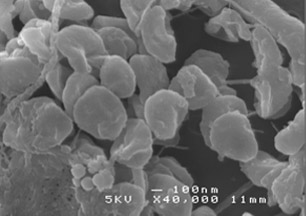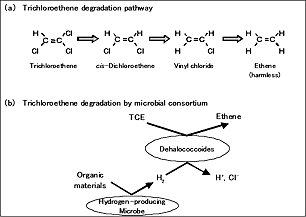2008
June 19, 2008
Bioaugmentation Technology for In Situ Degradation and Detoxification of Chlorinated Ethenes Endorsed for the First Time in Japan to Comply with the Guidelines (Ministry of Economy, Trade and Industry, Ministry of the Environment)
Kurita Water Industries Ltd. (headquartered in Shinjuku, Tokyo, CEO: Hiroshi Fujino) has developed a "bioaugmentation" technology, which is a clean-up process to detoxifying chlorinated ethenes in soil and groundwater by degrading it to harmless ethene. On June 9, it was approved for the first time in Japan as a technology for in situ degradation and detoxification of chlorinated ethenes in compliance with the "Guidelines on Use of Microbial-based Bioremediation," jointly established by the Ministry of Economy, Trade and Industry and the Ministry of the Environment.
We have previously developed biostimulation technology, which uses indigenous microbes in soil to degrade and detoxify contaminants, and successfully used it to clean up various contaminated sites. Our newly developed bioaugmentation technology will enable the bioremediation process to be used at other sites where chlorinated ethene-degrading microbes do not occur and so the biostimulation technology cannot be used (some 30% of the national land contaminated with volatile organic compounds). Other advantages of bioaugmentation are that it reduces clean-up time by up to 50% and cost by up to 30% compared with the conventional biostimulation approach (in-house comparison). With evidence that our bioaugmentation technology complies with these Guidelines, we will actively promote this technology to win orders in the market for the treatment of volatile organic compound-contaminated soil/groundwater.
1. Background
Recently, an increasing number of cases of soil/groundwater contamination with chlorinated ethenes, such as trichloroethene, have been treated by bioremediation technology using anaerobic microbes. Bioremediation can treat even the ground under factories or buildings and is about one-tenth of the cost of excavation. The most commonly used bioremediation technology is called "biostimulation", which uses existing degrading microbes to clean up contaminated land. However, this approach cannot be used at sites not inhabited by chlorinated ethene-degrading microbes (approx. 30% of the national land contaminated with volatile organic compounds).
To address this problem, from August 2002 to February 2007, we participated in the New Energy and Industrial Technology Development Organization’s (NEDO’s) project "Development of Technologies for Analyzing and Controlling the Mechanism of Biodegradation and Processing" and focused on developing a technology of injecting a pre-grown culture of degrading microbes into the ground (bioaugmentation).
After a review by the Ministry of Economy, Trade and Industry and the Ministry of the Environment from March 2006, the ministries endorsed our technology for in situ degradation and detoxification of chlorinated ethenes in June 2008 for the first time in Japan to comply with the "Guidelines on Use of Microbial-based Bioremediation."
Comparison of bioaugmentation and conventional biostimulation
| Bioremediation | General term for technologies to clean up contaminated soil, groundwater, etc. by utilizing the actions of microbes to degrade contaminants |
|---|---|
| Biostimulation | A bioremediation approach to clean up target sites by activating indigenous microbes by addition of nutrient materials, etc. |
| Bioaugmentation | A bioremediation approach to clean up target sites by injecting cultivated exogenous microbes into the soil along with of nutrient materials, etc. |
2. Features of bioaugmentation
- 1)Allows bioremediation to be used also for sites not inhabited by chlorinated ethene-degrading microbes.
- 2)Almost halves the clean-up time compared with the conventional biostimulation approach, which took almost a whole year, by injecting chlorinated ethene-degrading microbes (in-house comparison).
- 3)Reduces the purification cost by up to 30% compared with the conventional biostimulation approach (in-house comparison).
- 4)Ensures thorough degradation of chlorinated ethenes to harmless ethene by using the microbial consortium dominated by vinyl chloride degrading microbes (Dehalococcoides), whereas the conventional biostimulation approach sometimes failed to completely degrade chlorinated ethenes, a soil contaminant, depending on the kind of degrading microbes, resulting in the accumulation of highly toxic vinyl chloride, an intermediate product of degradation.
Model of trichloroethene degradation by Dehalococcoides

Scanning electron micrograph of microbial consortium used for bioaugmentation
3. Compliance with the "Guidelines on Use of Microbial-based Bioremediation"
1)Outline of the Guidelines
The Guidelines were established in March 2005 jointly by the Ministry of Economy, Trade and Industry and the Ministry of the Environment to ensure that bioaugmentation is safely implemented. Specifically, the Guidelines stipulate basic requirements for proper safety assessment/control procedures, in order to ensure the sound growth of the bioremediation industry and environmental conservation through wider application of bioremediation technology.
2)Our compliance with the Guidelines
Our technology is the third to be approved to comply with the Guidelines but is the nation’s first of these to be approved for in situ degradation and detoxification of chlorinated ethenes.
As noted, Dehalococcoides, the only microbe that can degrade chlorinated ethenes to harmless ethene, is the key microbe for our technology. However, as it is difficult to achieve pure culture of the microbe, we needed to establish a "microbial consortium" including other microbes that supply Dehalococcoides with hydrogen (energy source for growth) in order to use the microbe. We developed a unique enrichment procedure to maintain Dehalococcoides firmly (patent pending), and rigorously confirmed the safety of the culture. As a result, we succeeded in establishing a microbial consortium containing Dehalococcoides that satisfies the requirements of the Guidelines, thus making bioaugmentation using Dehalococcoides feasible for the first time in Japan.
4. Market and Prospects for Bioaugmentation
The overall market for the soil/groundwater remediation industry including soil/groundwater survey and land transactions is estimated to be worth 200 billion yen. For bioremediation targeting volatile organic compounds including harmful chlorinated ethylene, the market will be worth about 10 billion yen annually in three years.
In this market, we will actively promote our bioaugmentation technology to speed up the treatment process at lower cost than the conventional bioremediation approach, with the aim of receiving orders worth about 5 billion yen annually in three years.


